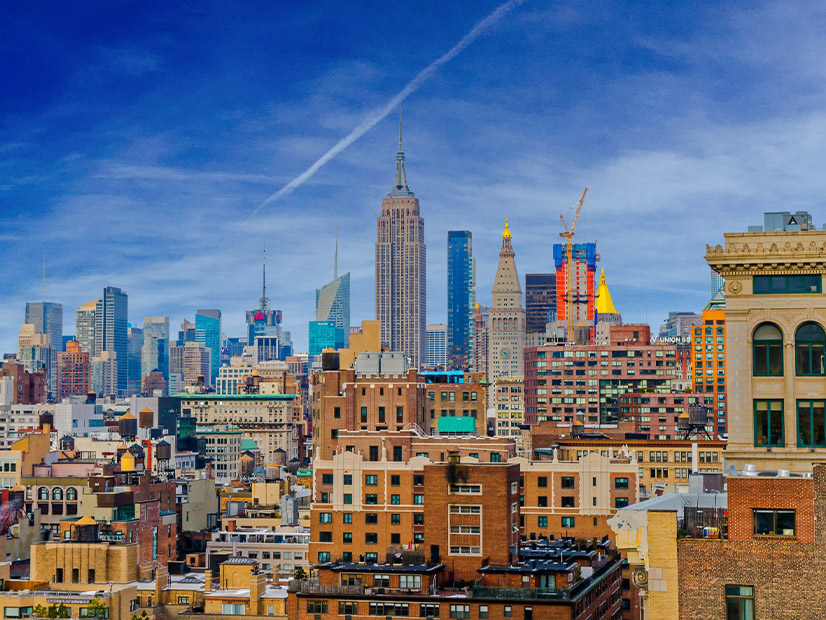
The New York City Department of Buildings (DOB) last week proposed new rules to carry out a 2019 local law aimed at reducing carbon emissions from the city’s largest buildings.
The agency also identified the 27,000 buildings that will be covered by Local Law 97 (LL97) and subjected to the first compliance deadline scheduled for 2025.
Enacted by the New York City Council three years ago as part of the NYC Accelerator program, LL97 established greenhouse gas emissions standards for most city buildings that exceed 25,000 square feet by requiring improved energy efficiency. The law also imposed stricter emissions reporting requirements on the covered buildings.
The rules proposed last week are intended to clarify and strengthen LL97 by setting building emission factors until 2050, simplifying administrative reporting processes, detailing formula for calculating a building’s annual emissions or energy usage, and setting up rules governing renewable energy credits (RECs) that property owners can buy to help meet targets.
The buildings subject to the rules range from government and military installations to religious centers, grocery stores and business offices, with the largest structures requiring initial compliance by 2024 followed by stronger limits in 2030.
LL97 was designed to cut emissions from the city’s largest buildings by 40% by 2030 and 80% by 2050. RECs, which were written into the law, could be bought by proprietors to help meet their emissions targets and would be used to help fund other renewable efforts or projects.
REC Rules ‘Far Too Weak’
Under the rules, the RECs can be generated by state renewable projects and are intended as economic tools to help building owners offset the emissions generated from electricity supplied by natural gas and avoid hefty non-compliance costs as they begin to bring their stocks into LL97 compliance.
Specifically, credits could be used to fund Tier 4 projects, such as the Clean Path New York and Champlain Hudson Power Express, which have seen recent implementation delays. (See NYSERDA Seeks 1-Year Delay for Tier 4 RECs)
In an email to NetZero Insider, DOB Press Secretary Andrew Rudansky said “this first batch of proposed rules” clarifies that building owners can only apply RECs to offset emissions from electricity use, preventing them from using RECs to offset other types of emissions associated with their buildings.
“The department will be releasing additional rules on how the use of RECs is limited in the future. Our rulemaking process will continue to be informed by careful study by the department’s Bureau of Sustainability along with close collaboration with our partner agencies, the Climate Advisory Board, the Local Law 97 Working Groups and also with state government officials,” Rudansky said.
Additionally, Rudansky said the DOB is “currently working with stakeholder partners to study RECs” and noted that credits have “always been part of the Local Law 97 equation,” pointing to language in the original law as evidence.
That language stipulates that a “deduction from the reported annual building emissions shall be authorized equal to the number of renewable energy credits purchased by or on behalf of a building owner.” It also requires that the resources generating eligible RECs be located in or directly deliverable to the New York grid operator’s New York City load zone; that the RECs be solely owned or retired on behalf of the building owner; and that they be generated in the same period as the reporting year.
“Covered buildings claiming deductions for renewable energy credits under this section must provide the department with the geographic location of the renewable energy resource that created the renewable energy credits. The [DOB], in consultation with the mayor’s office of long-term planning and sustainability, shall promulgate rules to implement this deduction,” the law states.
Despite the clarification, some environmental groups were still unsatisfied with the RECs provision.
In an online statement, a coalition of local organizations protested the new rules saying that although “Mayor [Eric] Adams is taking positive steps,” the current rules around RECs are “far too weak” and that moving forward the administration should “tightly limit RECs so they cover only up to 10% of a building’s total pollution.”
The DOB will be hosting an online public hearing on the proposed rules on Nov. 14. Public comments can be submitted to DOBRules@buildings.nyc.gov, while stakeholders can learn more about how to meet emissions targets through the NYC Accelerator program.


